NIOS Class 10 Economics Chapter 9 Demand Solutions to each chapter is provided in the list so that you can easily browse through different chapters NIOS Class 10 Economics Chapter 9 Demand and select need one. NIOS Class 10 Economics Chapter 9 Demand Question Answers Download PDF. NIOS Study Material of Class 10 Economics Notes Paper 214.
NIOS Class 10 Economics Chapter 9 Demand
Also, you can read the NIOS book online in these sections Solutions by Expert Teachers as per National Institute of Open Schooling (NIOS) Book guidelines. These solutions are part of NIOS All Subject Solutions. Here we have given NIOS Class 10 Economics Chapter 9 Demand, NIOS Secondary Course Economics Solutions for All Chapters, You can practice these here.
Demand
Chapter: 9
MODULE 4: DISTRIBUTION OF GOODS AND SERVICES
TEXTBOOK QUESTIONS (SOLVED)
INTEXT QUESTIONS 9.1
Q.1. Define demand.
Ans. Demand may be defined as the quantity of a commodity that a buyer is willing to buy at a given price per unit of time.
Q.2. Name the three components included in the definition of demand.
Ans. Three components included in the definition of demand are as follows:
(i) Price of the commodity.
(ii) Quantity of the commodity to be bought.
(iii) The time period.
INTEXT QUESTIONS 9.2
Q.1. State the law of demand.
Ans. The law of demand states that other factors determining the demand remaining constant, price of a commodity and quantity demanded are inversely related.
Q.2. What are the assumptions of law of demand?
Ans. Following are the assumptions of law of demand:
(i) Income of the buyer does not change.
(ii) Price of related goods does not change.
(iii) Tastes, preferences and fashion do not change.
Q.3. What will happen to your demand for apples if price of apples rises from ₹ 80 per kg. to ₹ 100 per kg. assuming that your income, tastes, preferences etc.
Ans. Demand for apples will fall.
INTEXT QUESTIONS 9.3
Q.1. What will happen to the real income of the buyer if price of a commodity falls?
Ans. Real income will increase.
Q.2. will be the shape of the demand curve when there is inverse relationship between price and its quantity demanded?
Ans. Demand curve will slop downwards from left to right.
Q.3. You are thirsty and you have already taken a glass of water. Whether the satisfaction derived from the second glass of water you drink, will increase or decrease?
Ans. Decrease.
Q.4. Draw a demand curve with the help of data given below:

Ans.
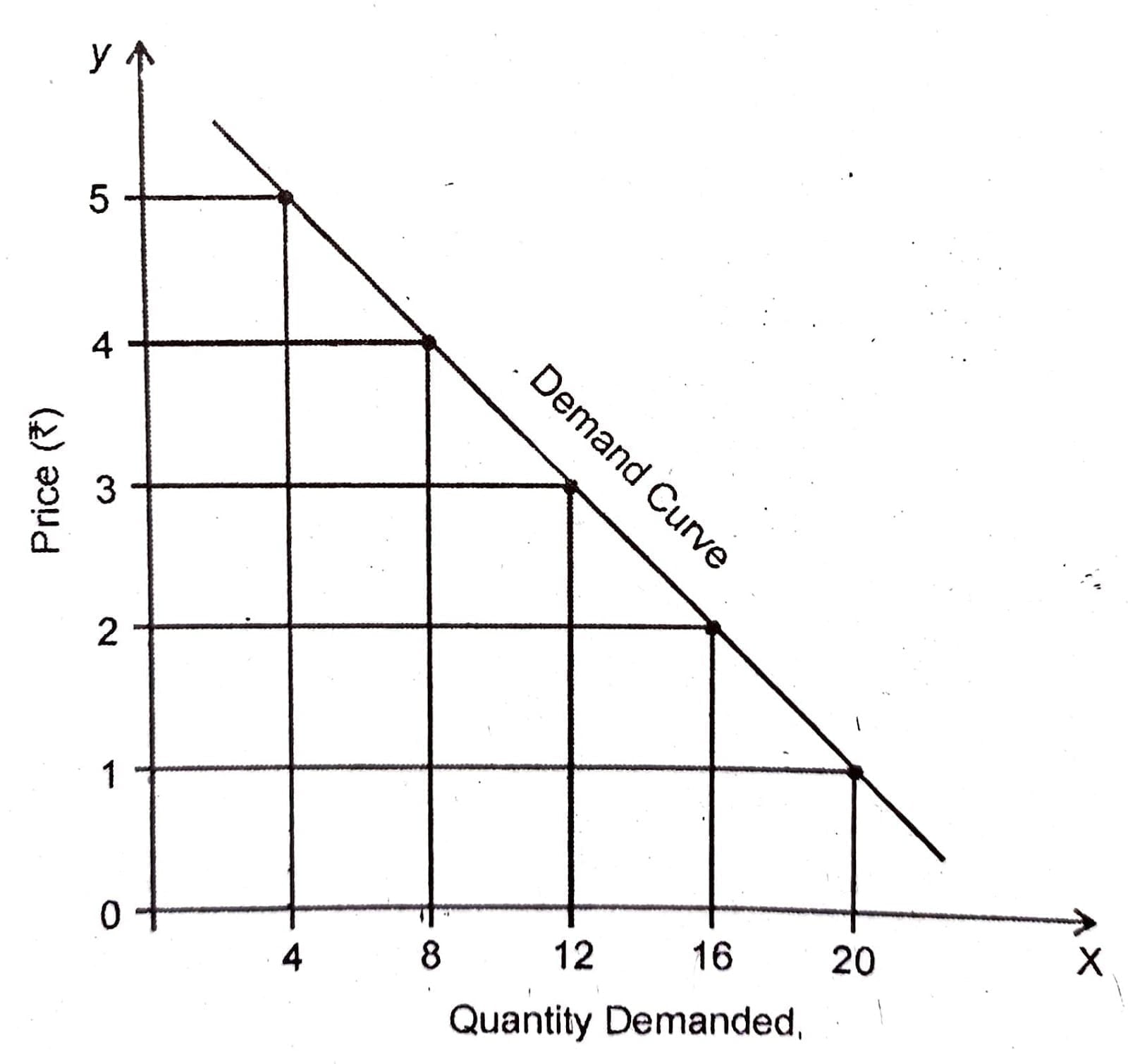
INTEXT QUESTIONS 9.4
Q.1. If there are only three households buying a commodity in the market, calculate the market demand in the table given below:
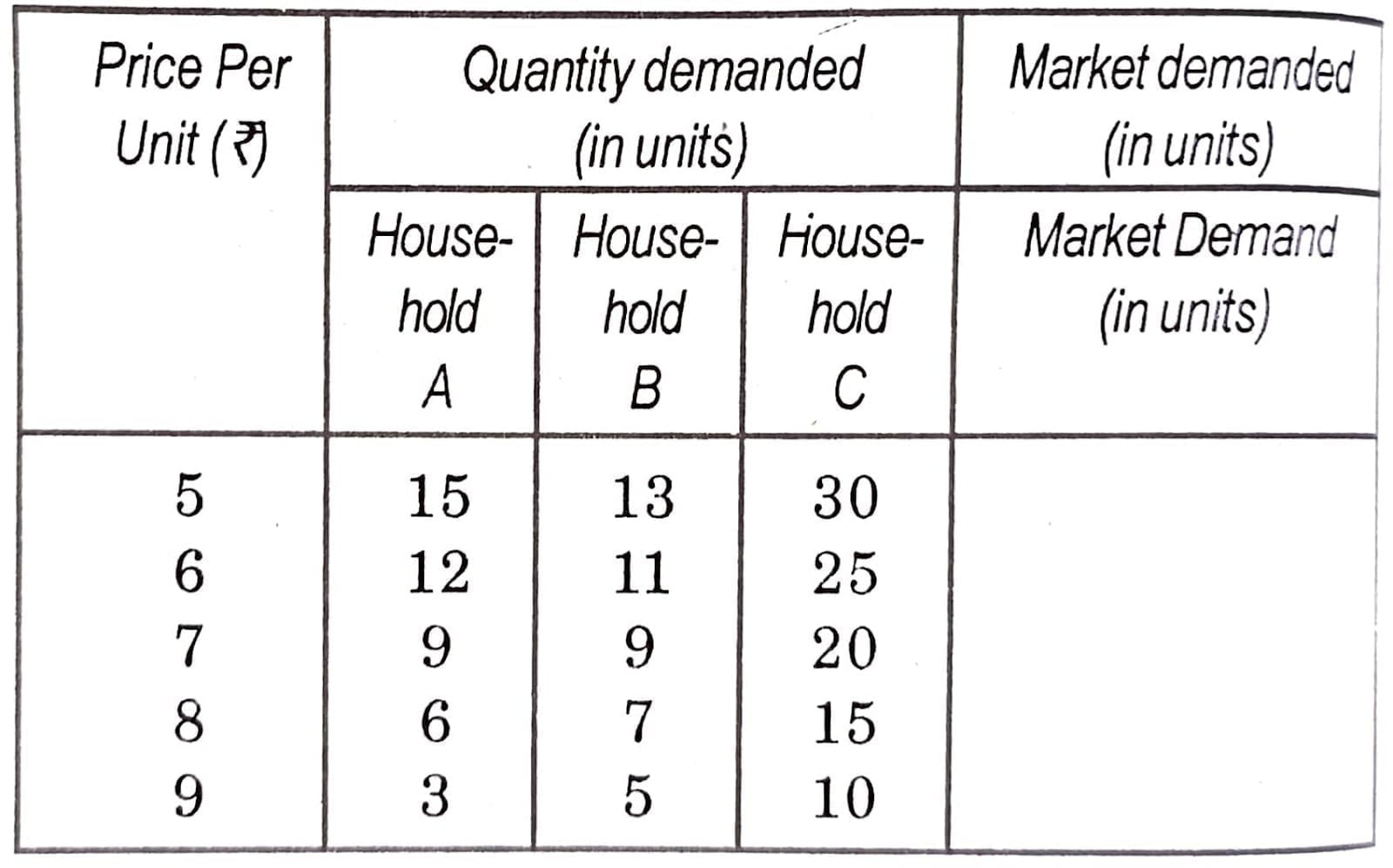
Ans.
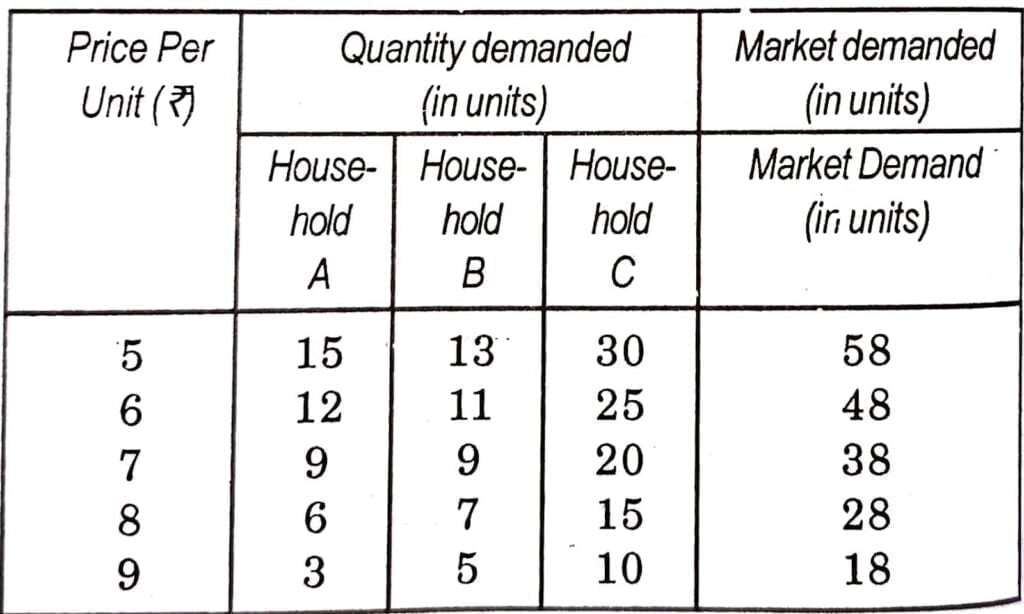
Q.2. Complete the following table:
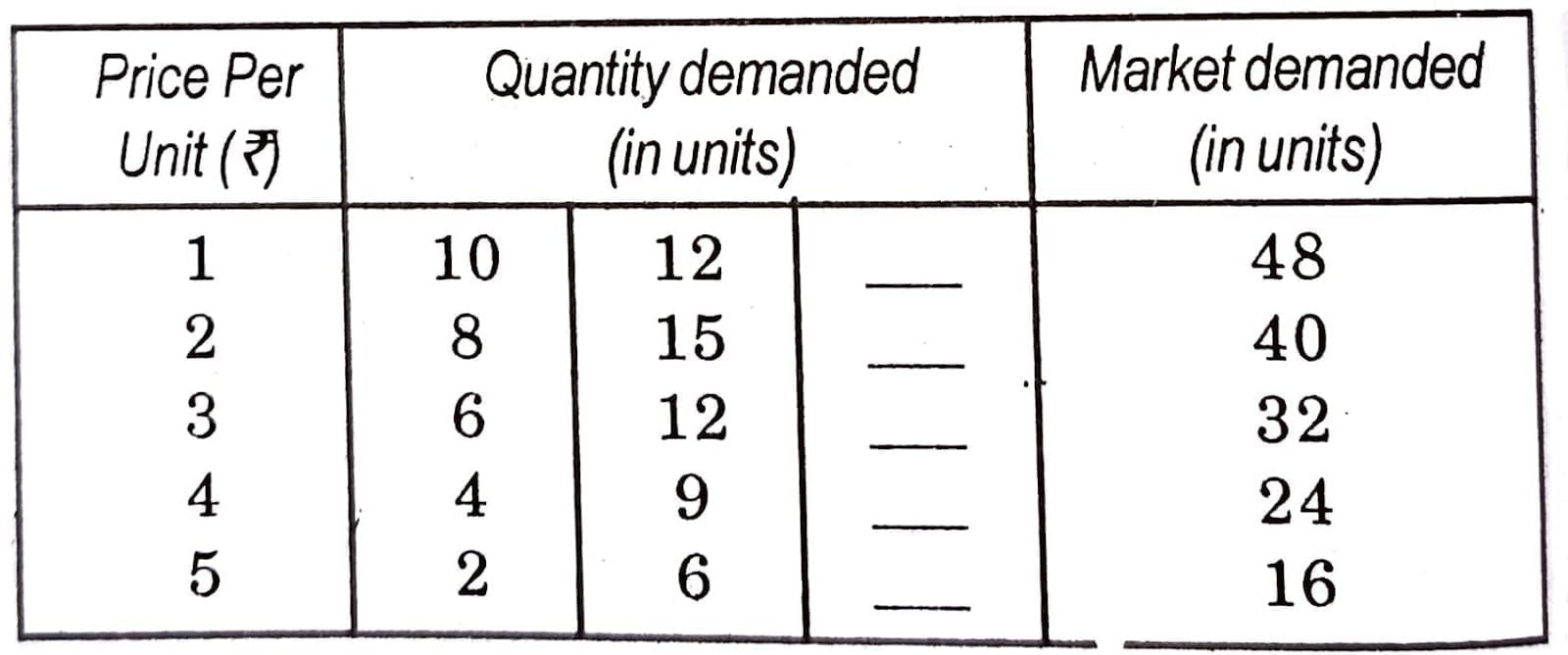
Ans.
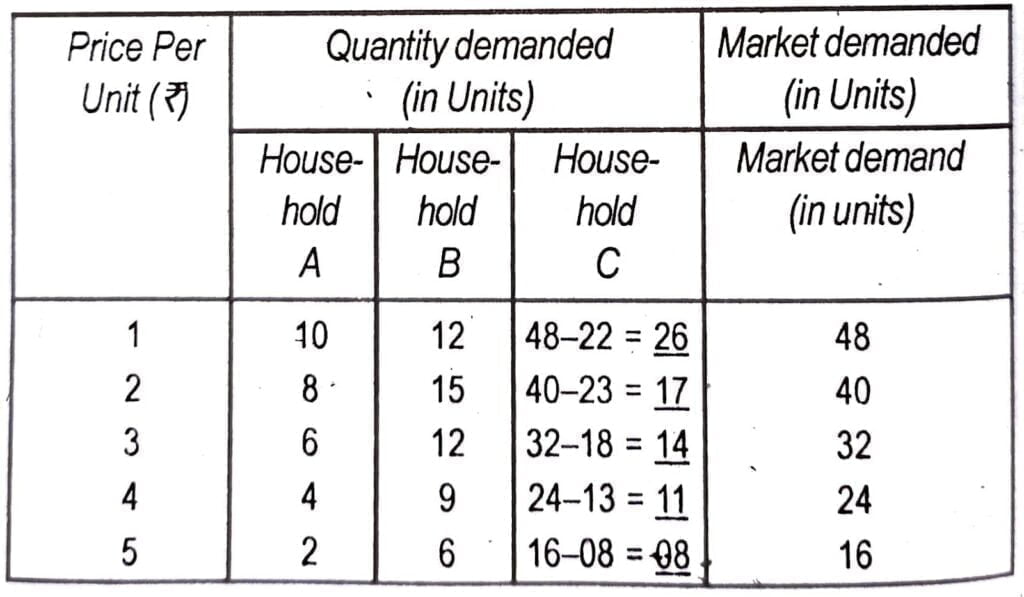
INTEXT QUESTIONS 9.5
Q.1. Name the four factors that affect the individual demand for a commodity.
Ans. Price of the commodity, price of related goods, income of the buyer, tastes, preferences and fashions.
Q.2. What will happen to the demand for tea if price of sugar increases?
Ans. Fall.
Q.3. What will happen to demand for Coke if the price of Pepsi falls?
Ans. Fall.
Q.4. Distinguish between normal goods and inferior goods.
Ans. Demand for normal goods increases with the increase in income whereas demand for inferior goods decreases with the decrease in the income of the buyer.
Q.5. Prepare a list of at least five items are in fashion now-a-days.
Ans. (i) Jeans.
(ii) Tops.
(iii) Electronic goods.
(iv) Watches.
(v) Ball-pens.
Q.6. Fill in the blanks with appropriate words:
(i) If the income of a buyer falls, his demand for inferior goods will _________.
Ans. Increase.
(ii) When price of ink increases, the demand for fountain pens will _________.
Ans. Decrease.
(iii) _________ is the number of buyers of a commodity in the market, higher will be demand for the commodity.
Ans. More.
(iv) If the distribution of income and wealth is more in favour of the _________ the demand for goods used by the poor will be more.
Ans. Poor.
TERMINAL EXERCISE
Q.1. Define demand. Distinguish between individual demand and demand for market.
Ans. Individual demand is the quantity of a commodity that an individual buyer is willing to buy at the given price at given time.
On the other hand, market demand is the total quantity of demand that all the individual buyers in the market are willing to buy at a given time.
Q.2. Briefly explain the determinants of individual demand for a commodity.
Ans. Factors determining the Demand for a Commodity: Following factors determine the demand for a commodity:
(i) Price of the Commodity: There is inverse relationship between the price of a commodity and its demand if other things remaining same. When the price of the commodity falls, its demand rises and vice versa.
(ii) Prices of related Goods: Related goods are of two types:
(a) Substitute goods. and
(b) Complementary goods.
Substitute goods are those goods which can be used in place of another whereas complementary goods are those goods which are used together to satisfy a want. There exists a direct positive relationship between the price and demand for substitute goods (tea and coffee) as shown in the diagram.

On the other hand there is a negative or reverse relationship between the price and demand of complementary goods. For example, we take pen and ink as complementary goods. If the price of pen increases, its demand will fall resulting into the fall in the demand of ink as it is used with it. It has been shown with the help of the diagram.
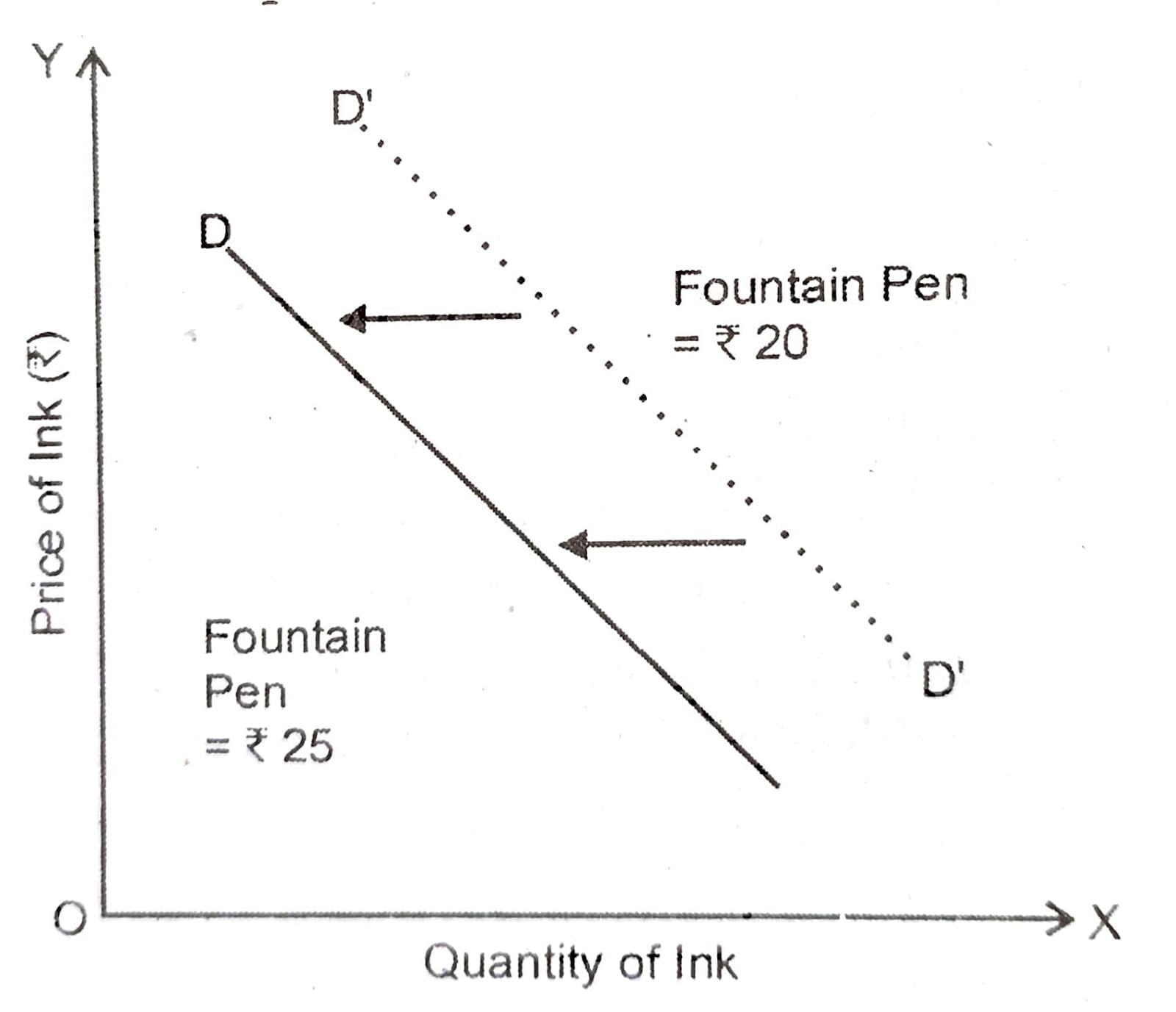
(iii) Income of the Consumers: There is direct relationship between the income and demand for normal goods, i.e. demand for normal goods increases with the increase in income and vice versa. In case of inferior goods, there is inverse relationship between the income and demand for goods. The demand for inferior goods fall with increase in income and vice versa.
(iv) Taste: Taste also affects the demand for a commodity. Favourable change in taste causes increase in demand and the demand curve shifts rightwards. But if there is unfavourable change in the taste, then the demand will fall and the demand curve will shift to the left.
Q.3. State the factors which may affect market demand for a commodity.
Ans. Following factors may affect market demand for a commodity:
(i) Number of buyers.
(ii) Distribution of income and wealth.
(iii) Climatic conditions.
Q.4. State and explain the law of demand with the help of a hypothetical numerical example/schedule.
Ans. Law of Demand: Law of demand states that the quantity demanded varies inversely with its price, other determinants remaining unchanged. This law explains the functional relationship between the quantity demanded and price. Prof. Marshall has defined it as “If other things remaining same, the amount demanded increase with a fall in price and diminishes with a rise in price”. Hence there exits inverse relationship between the price and quantity demanded. This law can be explained with the help of the following demand schedule:
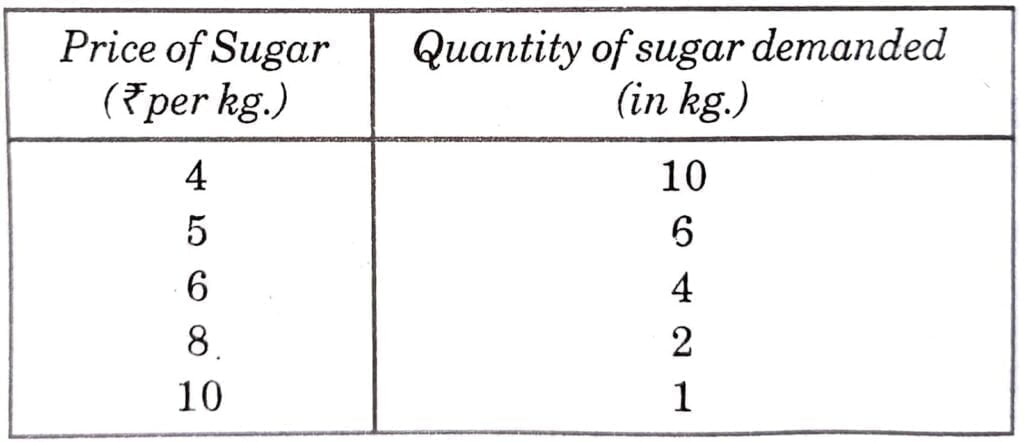
Q.5. What is a demand curve. Draw an individual demand curve with the help of a hypothetical demand schedule.
Ans. Demand Curve: Demand curve is a diagrammatic representation of law of demand. It slops downward from left to right.
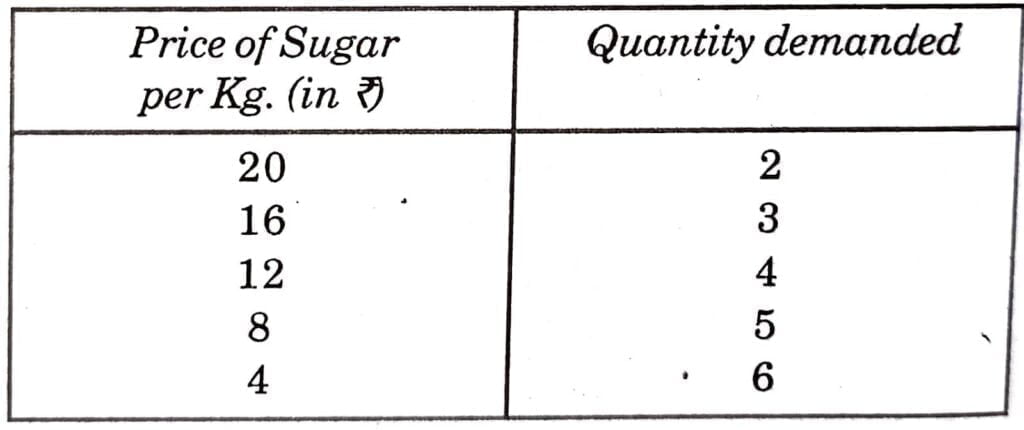
Drawing an individual demand curve with the help of above demand schedule:
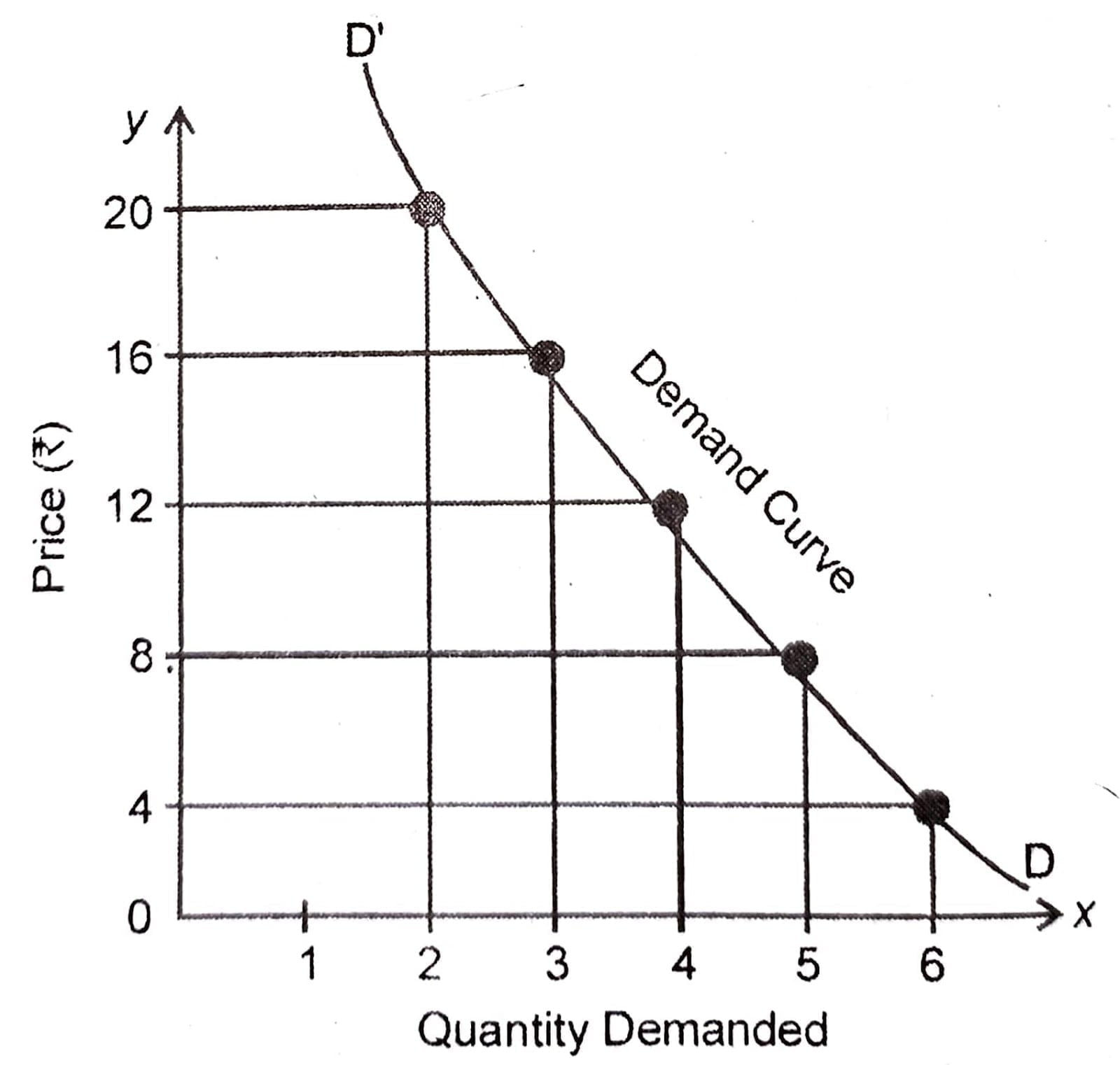
Q.6. Why does the demand curve slope downwards from left to right?
Ans. Demand curve slops downwards due to following reasons:
(i) Law of Diminishing Marginal Utility: According to this law, as the consumption of commodity increases, the utility from each successive unit goes on diminishing to a consumer. For example, a hungry person gets maximum satisfaction from the first chapatti, lesser satisfaction from second chapatti and still lesser from third chapatti and so on. If he gets more satisfaction, he will be ready to pay more and if he gets less satisfaction, he will be ready to pay less price it. It means he will be willing to buy more quantity of a commodity at lower price and less of it at higher price. The law of demand also provides the same information which will lead to downward slope of a demand curve.
(ii) Income Effect: Income effect refers to change in quantity demanded when real income of the buyer changes as a result of change in price of a commodity. Change in the price of a commodity causes a change in real income of the consumer. With a fall in price, real income increases. Accordingly demand for the commodity expands. For example, you buy mangoes from the market. the price mangoes is ₹ 40 per kg. and you buy 2 kgs of mangoes at this price. If the price of mangoes falls from ₹ 40 per kg. to ₹ 20 per kg., your real income or purchasing power is doubled and you can now buy double quantity i.e. 4 kg. of mangoes with the same money. Thus a buyer can buy more quantity of a commodity when its price falls and-less when its price rises leading to the downward slop of the demand curve.
(iii) Substitution Effect: Substituting a cheaper commodity for the relatively expensive commodity is called substitution effect. Alternatively it refers to the substitution of one commodity in place of the other commodity, when it becomes relatively cheaper. For example if the price of Coke falls, it becomes relatively cheaper than its substitute i.e. Pepsi. People start buying Coke in of Coke (Alternatively Pepsi is substituted by Coke), leading to more demand for Coke when its price falls. On the other hand, demand for the commodity will fall when its price rises. It will lead to downward slope of the demand curve.
Q.7. What is the reason behind the law of demand?
Ans. Reason behind the Law of Demand: Reason behind the law of demand is the law of diminishing marginal utility. According to this law. As gas more and more units of a commodity are consumed, marginal utility derived from each successive. unit goes on falling. In other words, as a person consumes more (or additional) units of a commodity the extra utility (i.e. marginal utility) derived from each successive unit goes on falling because the desire for that commodity tends to fall.
SOME IMPORTANT QUESTIONS FOR EXAMINATION
VERY SHORT ANSWER TYPE QUESTIONS
Q.1. What is demand?
Ans. Demand refers to the quantity of a commodity that a buyer is willing to buy at given price per unit of time.
Q.2. Give an example of demand.
Ans. Ram purchased 10 kg. of rice at the rate of ₹ 50 per kg. in 7 days.
Q.3. What does the definition of demand include?
Ans. The definition of demand includes three components:
(i) Price of the commodity.
(ii) Quantity of the commodity bought.
(iii) Time period.
Q.4. “Mr. Ram purchased 5 kg. of mangoes at the rate of ₹ 120 per kg.” Is this an example of demand? Give reason in support of your answer.
Ans. No. It is an example of demand, because in this example, third component i.e. time period is not mentioned.
Q.5. “Mr. Sohan paid 30 per litre for milk last month.” Is this an example of demand? Give reason in support of your answer.
Ans. No, this is not an example of demand, as in this example, third component i.e. quantity of milk is not given.
Q.6. When does a desire become a demand?
Ans. A desire becomes a demand, when the price is paid by the person who has desired it.
Q.7. Name the two types of related goods.
Ans. Two types of related goods are:
(i) Substitute goods. and
(ii) Complementary goods.
Q.8. What are substitute goods?
Ans. Substitute goods are those goods which can be easily used in place of each other such as tea and coffee.
Q.9. What are complementary goods?
Ans. Complementary goods are those goods which are used together in satisfying a particular wants. Car and petrol are complementary goods.
Q.10. What are normal goods?
Ans. Normal goods are those goods whose demand increases with the increase of income of the buyer. Full cream milk, butter are examples of normal goods.
Q.11. What are inferior goods?
Ans. Inferior goods are those goods whose demand decreases with the increase in income. Jowar, bajra, toned milk etc. are inferior goods.
Q.12. Below is given Varsha’s demand for mangoes.
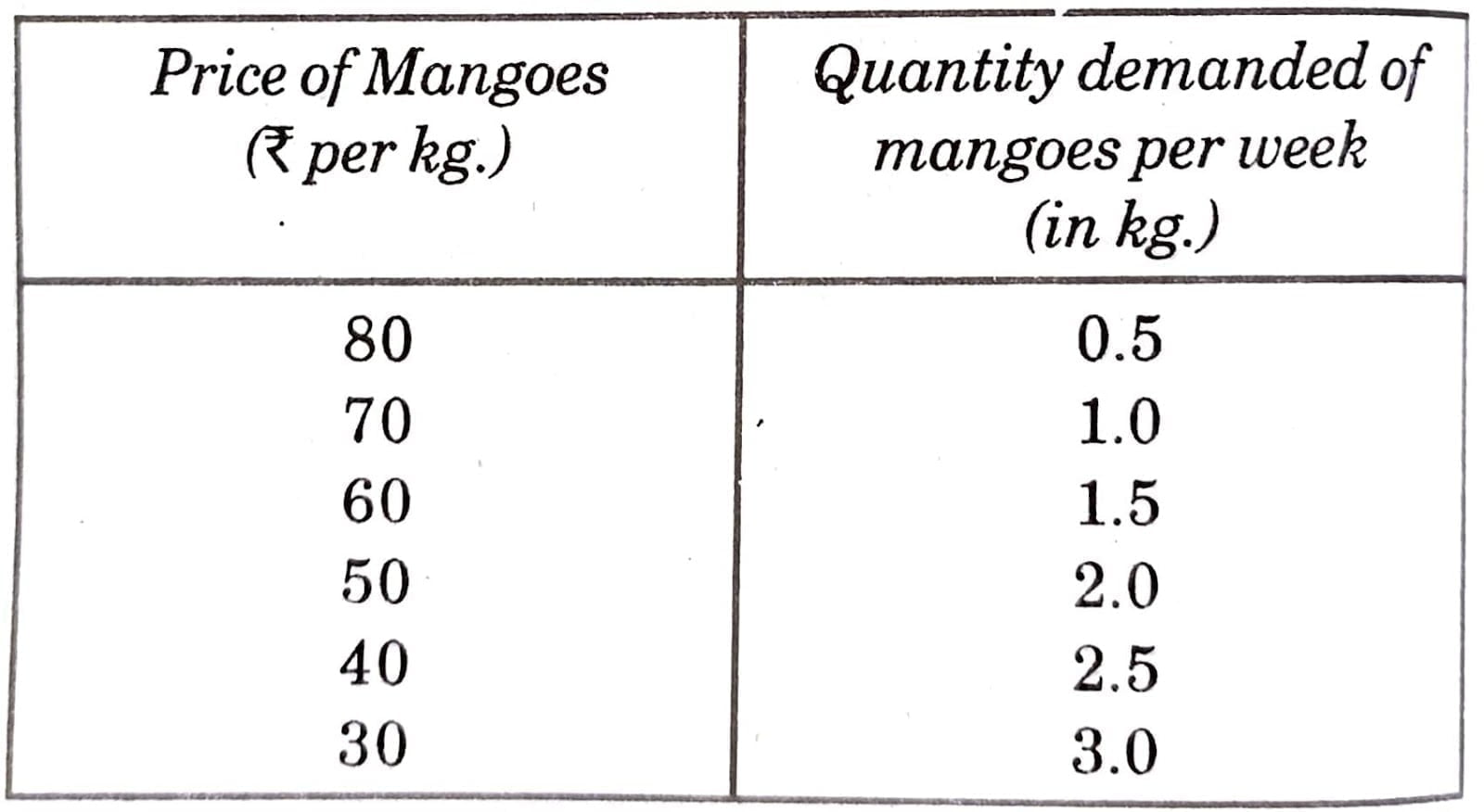
Answer the following questions:
What is Varsha to demand for mangoes when the price is ₹ 60 and ₹ 30 per kg.
Ans. Varsha’s demand for mangoes is kg. 1.5 kg. at ₹ 60 per kg. and 3.0 kg as ₹ 30 per kg.
Q.13. Give two examples of a pair of commodities that are substitutes of each other.
Ans. (i) Tea and Coffee.
(ii) Scooter and Car.
Q.14. Give two examples of a pair of commodities such that one of them is complementary to the other.
Ans. (i) Car and Petrol.
(ii) Tea and Sugar.
Q.15. If price of good x rises and this leads to decrease in the demand of y. How are two goods related?
Ans. x and y goods are complementary.
Q.16. On what basis inferior good is distinguished from normal good?
Ans. On the basis of change in income demand for inferior goods falls with increase income whereas demand for normal goods increase with the increase in income.
Q.17. If quantity demanded of a commodity X falls as household income rises, what type of commodity X is?
Ans. Inferior commodity.
Q.18. What will happen to demand for a commodity if the price of substitute falls?
Ans. Demand for the commodity will fall.
Q.19. How does unfavourable change in taste of a product will affect its demand?
Ans. The demand for the good will fall.
Q. 20. What will happen to demand for a commodity if the price of complementary goods changes?
Ans. With the increase in the price of complementary goods its demand will decrease and with the decrease in the price of its complementary goods its demand will increase.
Q.21. Why does demand for petrol increase with the fall in the price of cars?
Ans. The demand for cars will increase with the fall in the price of cars. Consequently the demand for petrol will increase as cars and petrol are complementary goods.
Q.22. If quantity demanded of a commodity X falls, as household’s income decreases, what type of good X is?
Ans. Good X is normal.
Q.23. How will an increase in price of coffee affect demand for tea?
Ans. Demand for tea will increase.
Q.24. Give two examples of normal goods and two examples of inferior goods.
Ans. (i) Normal Goods: (a) Wheat and (b) Scooter.
(ii) Inferior Goods: (a) Jowar and (b) Tonned Milk.
Q.25. From the following individual demand curve, state the quantities of goods demanded when the price of good is ₹ 40 per unit.
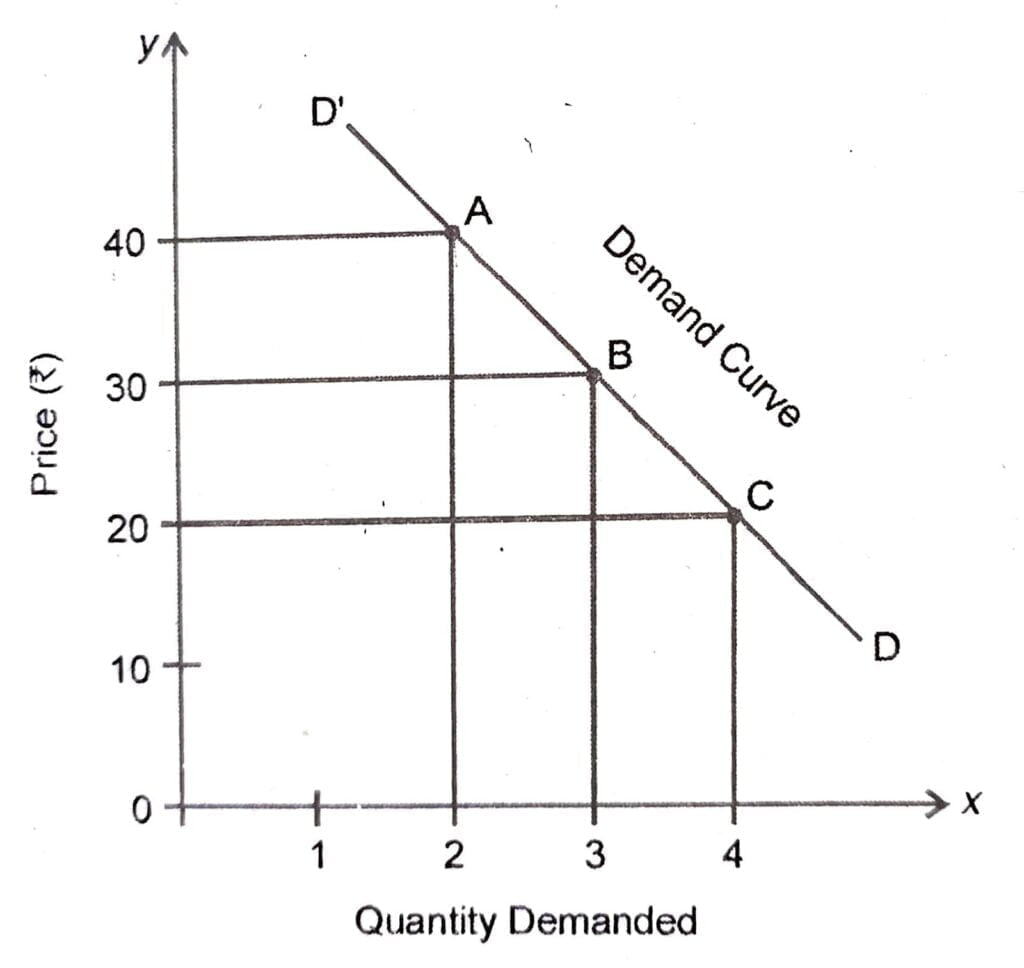
Ans. 2 units of good will be demanded when the price is ₹ 40 per unit.
SHORT ANSWER TYPE QUESTIONS
Q.1. Which component of the definition of demand is not mentioned in the following of demand:
(i) Nitin bought two pairs of shoes last month.
(ii) Mr. Jafri purchased 5 kg. of apples at ₹ 40 per kg.
(iii) Mrs. Harmit Kaur paid ₹ 25 per litre to milk last month.
Ans. Example.
(i) Nitin bought 2 pairs of shoes last month.
(ii) Mr. Jafri purchased 5 kg. of apples at ₹ 40 per kg.
(iii) Mrs. Harmit Kaur paid ₹ 25 per litre for milk last month.
Component of demand not existing:
(i) Price of pairs of shoes is not given.
(ii) Time period is not given.
(iii) Quantity of milk purchased is not given.
Q.2. Explain any three determinants of demand.
Ans. Determinants of demand refers to the factor exerting influence over the quantity demanded of a particular commodity.
Three major determinants of a demand are as follows:
(a) Prices of related Goods: An increase in the price of a substitute goods causes an increase in demand e.g. tea and coffee. While an increase in the price of a complementary goods causes a decrease in demand e.g. car and petrol.
(b) Income: With an increase in consumer’s income, the demand of a product increases or decreases, depending on whether the good is normal or inferior.
(c) Tastes: A favourable taste change increases the demand for a good and vice versa.
Q.3. What is meant by cross price effects? Give two numerical examples to illustrate this.
Ans. Cross price effect means how the demand for one particular product is affected by a change in the price of another.
Q.4. There are three consumers in a market. Their demand schedules are given. Prepare market demand schedule.
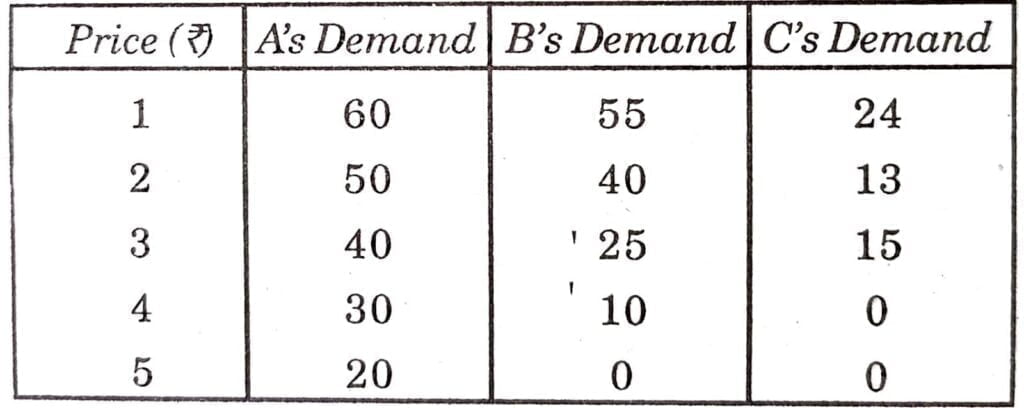
Ans. Market Demand Schedule
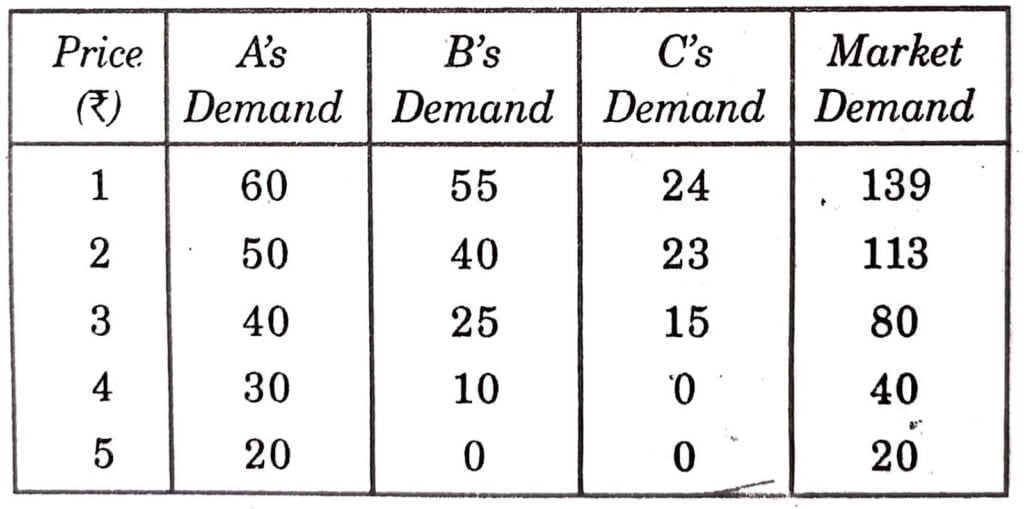
Q.5. Consider a market where there are just two consumers and suppose their demands for the goods are as follows:

Calculate the market demand for the good.
Ans.
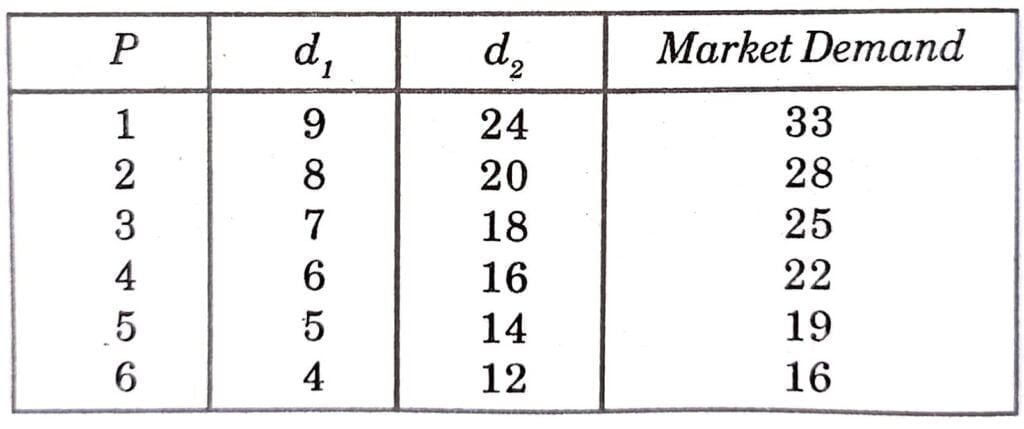
Q.6. Calculate market demand from the following data:
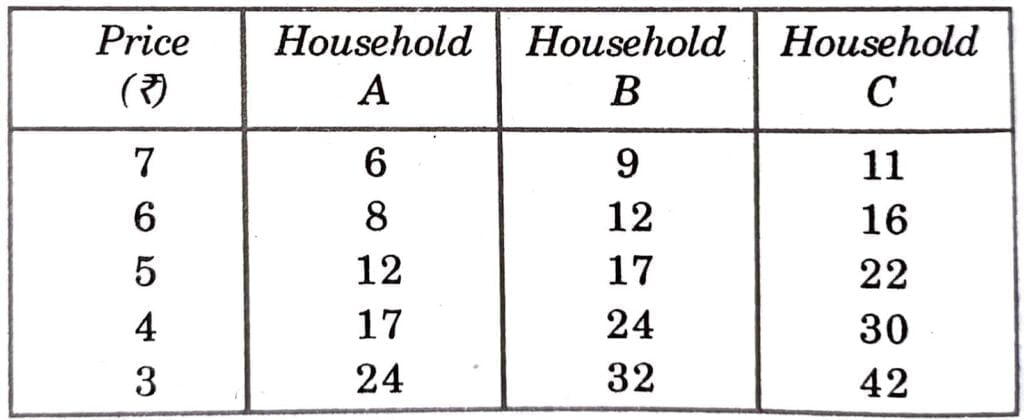
Ans. Market Demand
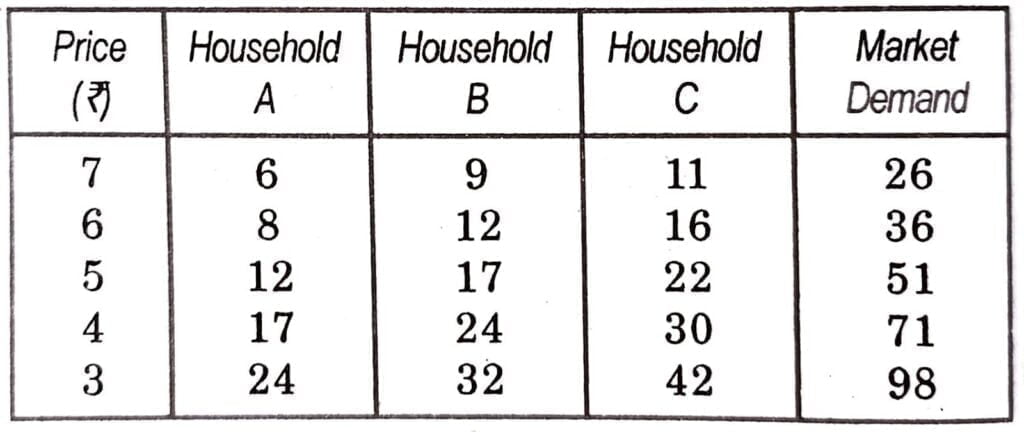
Q.7. Prepare demand schedule on the basis of information given below:

Ans. Demand Schedule


Hi! my Name is Parimal Roy. I have completed my Bachelor’s degree in Philosophy (B.A.) from Silapathar General College. Currently, I am working as an HR Manager at Dev Library. It is a website that provides study materials for students from Class 3 to 12, including SCERT and NCERT notes. It also offers resources for BA, B.Com, B.Sc, and Computer Science, along with postgraduate notes. Besides study materials, the website has novels, eBooks, health and finance articles, biographies, quotes, and more.



